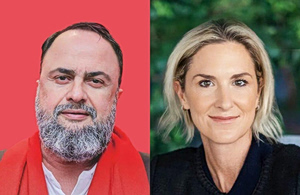TEL AVIV—After Aviva Siegel was taken from Kibbutz Kfar Aza and held prisoner in Gaza, her captors would film her for hostage videos, telling her exactly what to say.
Held for 51 days in 13 locations —including in tunnels where she had trouble breathing, went long hours without food or water and was taunted by her captors—Siegel said she struggled to stay on script. Her captors’ production crew included a cameraman and a person who spoke Hebrew, and they were quick to remind her of her lines.
“‘You didn’t say that you’re 62.’ ‘You didn’t say that you’re from Kfar Aza.’ ‘You didn’t say that Bibi needs to bring you back,’” she said, using the nickname of Israeli Prime Minister Benjamin Netanyahu .
“I always forgot something,” said Siegel, who was forced to speak for the camera on three occasions and filmed eating at least twice. “So I had to say it again and again and again.”
The effort that Hamas and other Gaza militants have devoted to filming the roughly 250 people taken during the Oct. 7 attack on southern Israel—even amid fierce fighting in the enclave—shows the centrality of hostage-taking to the U.S.-designated terrorist group’s strategy for putting pressure on Israel and surviving the war.
The group ordered militants holding hostages to take frequent photos and videos, said Arab cease-fire mediators and officials who speak directly to Hamas. That raw material is kept in a large archive and later shared by teams outside Gaza, the people said. The orders are to apply pressure on the Israeli government and attack Netanyahu, they said.

FILE PHOTO: Israeli-American Hersh Goldberg-Polin, who was taken hostage by Hamas during the October 7 attacks, and whose body has been found underground in the Rafah area of the Gaza Strip and returned to Israel. Courtesy of Bring Them Home Now/Handout via REUTERS
The paces the hostages are put through to produce the videos add deeply uncomfortable episodes to an already terrifying ordeal. Israeli officials and hostage advocates have called the videos a form of psychological terror.
Production of hostage videos, made under duress, can be a war crime under international law. Israeli media has previously avoided airing them. But as the months have gone on without a deal, some of the increasingly desperate families of hostages have given their blessing to air some of them to keep the issue on the public agenda.
Families that have seen videos of their loved ones say they are difficult to watch, but some have clung to them as a rare sign that the hostages might be alive.
“It’s a very slow-motion form of trauma and torture,” Rachel Goldberg-Polin told The Wall Street Journal last month when asked about a video released in April that showed her son, Hersh, alive. “And the ironic, dismaying part of that is how many hostage families say to us, we would give anything to have that video.”
Many of the hostages have been forced to record videos at some point during their time in Gaza, according to the Hostages Families Forum, a group that represents most of the hostage families. Hamas doesn’t always make the videos public. Some have surfaced only because the Israeli military found them during its ground offensive in the enclave.
Chen Almog-Goldstein, another released hostage who was taken from a kibbutz with her three children, said her captors filmed them inside the tunnels on their second day in Gaza. Captors placed Israeli snacks in the terrified family’s hands. The video was never released.
Gershon Baskin, an Israeli hostage negotiator who helped broker a previous prisoner exchange with Hamas in 2011, said the group is making more aggressive and sophisticated use of videos in this war. The videos have displayed a good understanding of Israeli society, as well as professional editing, he said. He noted that Hamas’s use of Hebrew had also improved. Some videos have included lines from the Old Testament.
“Hamas is exploiting the public sentiment, which is beginning to become a lot louder and a lot larger,” Baskin said. “Hamas wants this war to end, and this is how they think that pressure can be put on Netanyahu.”
Israel recovered the bodies last week of Hersh Goldberg-Polin and five other hostages who appeared to have been killed by Hamas . Since then, the militant group has released new videos of Goldberg-Polin and the other hostages showing them speaking on camera, begging to be released.
The videos, which according to freed hostages are carefully scripted, appear aimed at pressuring the Israeli public to push for a deal that would secure a cease-fire and exchange Palestinian prisoners for some of the 97 hostages taken on Oct. 7 who are still held in Gaza.
As many as half of that number are feared to be dead . Hostage families and many in Israel’s security establishment are concerned time is running out for the rest given the danger and difficult conditions they face. Anger is growing at Netanyahu, who critics say is stymying an agreement. He says his hard line is aimed at securing better terms in any deal.
Since the bodies of the six slain hostages were brought back to Israel last weekend, large protests have erupted across the country. The demonstrations have been noticeably angrier and have featured mock coffins draped in Israeli flags to represent the dead hostages.
On Saturday, hundreds of thousands of Israelis took to the streets of Tel Aviv in support of a hostage deal, according to estimates by organizers.
“I think that they have an enormous impact on Israeli society, and that’s what they’re aiming to do,” Baskin said of Hamas and the videos.
Released hostages told the Journal that militants forced them to take the videos starting in their very first days in captivity. While many of the hostages said they were genuinely angry with Netanyahu and felt abandoned, they didn’t have the freedom to speak as they wanted.
But some hostages said they conveyed their own thoughts in videos.
Danielle Aloni, who was kidnapped with her 6-year-old daughter, shouted in one video last October the word “Now!” The cry was later recited by crowds at protests in Israel to free the hostages.
“The anger and the shouts were authentic from my heart. I screamed from my heart and not because someone forced me to scream or shout. This is what captivity does to a person,” Aloni said, adding that Hamas was “pleased” with the impact of the video.
Once, a militant tried to make Siegel more presentable by giving her a brush to neaten her hair, which by that point was full of knots. When she refused, the militant tried to get her to put her hair in a clip, but she remained firm.
“I knew what I looked like. I was disgusting. I was so dirty,” she said. “I looked at him, and I picked my hair up, and I said, ‘beautiful,’” she said. “A couple of hours later, he told me to come into the other room and that they were going to take a picture of me. So I understood that he wanted me to look better while taking the pictures.”
Siegel was taken hostage with her husband, Keith, 65, who she was held with in Gaza until her release. Both are U.S. citizens. He appeared in a video in late April and is still being held.
In May, the Israeli military released an unpublished video that it found inside Gaza showing Ella Elyakim, an 8-year-old girl who was kidnapped with her sister from a kibbutz in Israel, reciting lines for the camera for a hostage video. The military said the footage was taken a few days after she was kidnapped on Oct. 7.
“My name is Ella Elyakim, the daughter of Noam, and I’m eight years old, and I’m asking Bibi to release us, and I’m a prisoner of Hamas,” Elyakim said in the video, wearing a yellow shirt with white hearts while standing in front of a large Hamas flag. She was released in a cease-fire deal in November.
Qatar and Egypt have tried to stop Hamas from releasing any videos of children who were taken as hostages, the Arab intermediaries said.
Siegel said her captors would sometimes film videos of her during a meal. “They used to make food and put it on the table,” she said. “We had to sit next to them and smile and say everything is OK, just for the picture.”
Palestinian Islamic Jihad, another U.S.-designated terrorist group, in June released a montage of videos taken of Elad Katzir that included scenes of him eating a large meal and getting his hair cut, apparently to show he had been treated well. Katzir’s body had been recovered in April. The video implied that hostages had been killed by Israel’s military campaign in the Gaza Strip.
Israel, which is closely collecting intelligence and information on the whereabouts and status of the hostages, uses the videos to try to gain more information, although Hamas is careful not to reveal any information about their location and backgrounds are often plain or partly blurred.
“I’m sure that they have doctors looking at them and determining what their weight is, what their physical situation is, how their eyes look all different, dissecting every single frame and picture to see how the hostages are being kept,” Baskin said.
Earlier in the war, Hamas released several videos announcing the death of hostages and showing footage and pictures of dead bodies. Those materials were pieced together with other information and analyzed by a special committee tasked with determining whether hostages taken on Oct. 7 had died.
Write to Anat Peled at anat.peled@wsj.com


